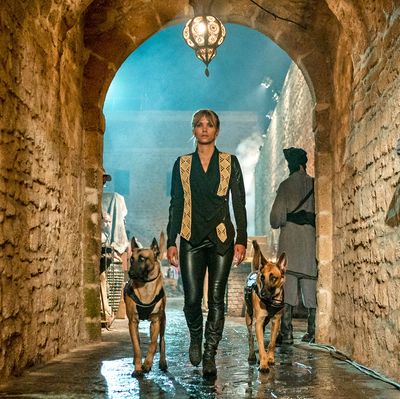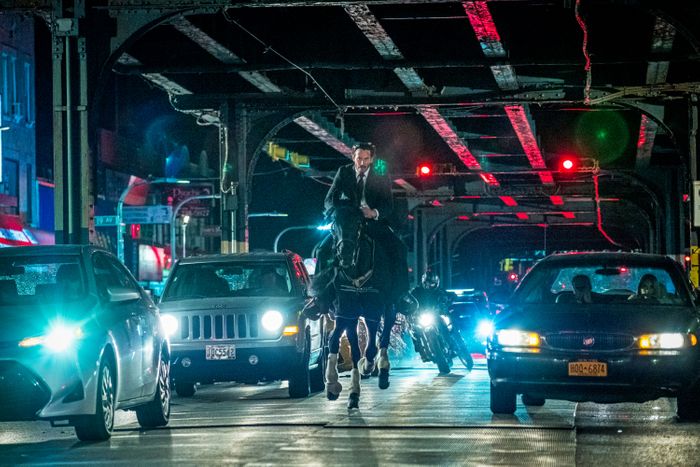
A neon-saturated fever dream of unrelenting murder, martial-arts brawls, and mob-orchestrated mayhem, John Wick Chapter 3 — Parabellum plays out as a nearly unbroken series of action set pieces, each one more gonzo, funnier, and spectacular than the next. Keanu Reeves is back as our indefatigable superassassin of few words (and title fame), who proceeds to dispatch a legion of professional killers using whatever is at his disposal in a given moment: he makes horses mule-kick bad guys into unconsciousness, battles ninjas with a samurai sword astride a motorcycle, and offs one contract killer — out for the $14 million bounty that has been placed on Wick’s head by a shadowy criminal organization known as the High Table — by shoving a book down his throat among the stacks at the New York Public Library.
But arguably, Parabellum’s most jaw-dropping sequence is a dog fight — as in a fight that actually involves the use of dogs. As any Wick completist can attest, canine companionship is key to these movies’ mythology; the body count in 2014’s debut John Wick only began to pile up when the Russian mafia murdered the hitman’s beloved pup. Hence, there’s a certain ineluctable logic to showcasing him — alongside Halle Berry as a mob doyenne constantly shadowed by a pair of ferocious Belgian Malinois — battling an army of foes with the dogs serving almost like fang-bearing tactical missiles. Encased in bulletproof kevlar, they scramble up walls and leap through the air, coming out of nowhere to bite at least two bad guys directly on the dick and enable dozens of our heroes’ kill shots through their fury and speed. In one of the more poignant dog-human fight synergies, one of the four-legged friends even springboards off Berry’s back to go for a would-be assailant’s jugular.
Turns out that director Chad Stahelski originally intended to put a similar sequence in 2017’s John Wick Chapter 2. But the former stunt coordinator — who choreographed innovative action sequences in such hits as The Hunger Games, 300, and X-Men Origins: Wolverine, and now ranks among the foremost auteurs of Gun-Fu — opted to leave it out due to scheduling conflicts. Crucially, a key piece of doggy dream casting fell through. “I went out and looked for the most talented show biz dog I could find and we found this dog, Jumpy, who had his own show on Nickelodeon — super-trained Australian Collie,” Stahelski says. “But Jumpy was pretty booked. So we couldn’t get Jumpy. I didn’t put in enough time and research. So literally, when they asked us if we could come up with ideas for [John Wick] number three, the number-one thing on the list was, ‘I’m going to do something with fucking dogs. I don’t care what. I’m going to figure this out.’”
A dog fight was indeed written into the script. Then during preproduction, the director exhaustively canvased top-tier animal experts and eventually enlisted Andrew Simpson whose primary renown comes from serving as the (dire)wolf wrangler on Game of Thrones. Simpson, in turn, extensively consulted with officials from various branches of the military including the Joint Special Operations Command and Army Rangers who use dogs in tactical and attack capacities. He proved instrumental in selecting the breed of dog for Parabellum: the Belgian Malinois, which are typically employed by law enforcement for bomb- and drug-sniffing, and which Stahelski describes as, “incredibly intelligent, incredibly disciplined, and also incredibly athletic with a lot of energy. A leaner, meaner version of a German Shephard.”
Although Berry’s icily regal hitwoman-turned-boss lady Sofia appears on screen with only two dogs, five puppies were brought in for the production: two males and two females who could be swapped in and out for various takes, and a fifth “stunt dog” named Santana who was prized for his athleticism. Eight months before filming they began training in what the director calls “doggy jiu-jitsu,” working with Simpson and other animal experts on a kind of rough play that could mimic aggressive attacking when the cameras rolled. Throughout it all, utmost care was taken to ensure both dogs’ physical and emotional safety. “On previous films, when you see a dog attacking a human being, it is a dog trying to injure a human being,” he tells me, seated in a conference room in the Santa Monica offices of Wick 3’s distributor Lionsgate. “The dog has mentally gone to a place of life and death. ‘Attack. I’m going to kill.’ It’s very violent and emotionally draining for the animal. You see the guy sticking his arm way out — that wasn’t going to work for us.”
“You don’t want to hurt the animal,” Stahelski continues. “You don’t want to hurt their teeth. You don’t want to freak them out and stress the animal. You want it to be fun for them. So rather than teach fight-or-flight or survival mode, Andrew worked with the animals to be like, ‘For us, this is playtime!’”
Five months before filming, the stunt team for the dog-fu showdown were brought in to train with the animals — a bonding exercise intended to acclimate the dogs and their scene partners to one another, heading off conflict on set. Berry, for her part, had begun a demanding training regimen with all five dogs a month earlier, spending up to three hours a day, seven days a week to effectively become one of the dogs’ trainers. “After five, six hours of martial arts and gun training, she had to go to the dog kennel training facility,” the director recalls. “Some days it was just playing catch with them. Other days it was full rehearsals. Some days it was just feeding them. Just letting the dogs know, ‘This is the Alpha.’ She is the one giving them commands.”
In the dog-fu sequence in the film, John Wick has traveled to Morocco to try and persuade Sofia to help him reach a High Table overlord there who can, in turn, connect him with an even higher-ranking overlord capable of taking the multi-million bounty off the hitman’s head. But of course, nothing goes as planned.
Shooting in the seaside city of Essaouira presented an unexpected challenge that could have rendered those countless hours of doggy jiu-jitsu training pointless. Specifically: around 1,000 feral cats that prowled the western Moroccan town looking for fish dropped or discarded by local fishermen. “We ended up hiring, I’m not shitting you, 30 cat wranglers,” Stahelski says. “We built these little kitty condos to house several hundred cats for the night. We’d shut the doors and just feed them. Then the sun would come up, we’d open the doors, and all the cats would run back and do their thing.”
In most films featuring scenes in which dogs maul people, the attacks adhere to a tried and true formula more safe than realistic — the bites tend to occur on an arm or leg rather than anywhere remotely fatal. For Parabellum, the action coordinators devised a specific body armor for the stuntmen that was protective but still soft enough that the dog could bite it full force without risking injury. And as part of their training, the dogs were encouraged to go berserk at the sight of the color green. Whenever the filmmakers wanted a specific body part to be mauled in a scene, they placed a small green velcro chew toy on that part of the stuntman’s special padding.
Setting in motion the dog-fu scene, a smarmy mobster played by Game of Thrones co-star Jerome Flynn attempts to shoot one of Sofia’s canine companions but fails — and gets his man junk savagely mutilated by the mutt for his effort. It begged one last question: is dog dick-chomping a real thing? “We love crotch biting,” says Stahelski, breaking into a wide smile. “In the combative world, in a very violent setting that these animals are used for, that’s a primary target. Soft spots.”
He adds: “I mean, if you were a dog, where would you bite?”




